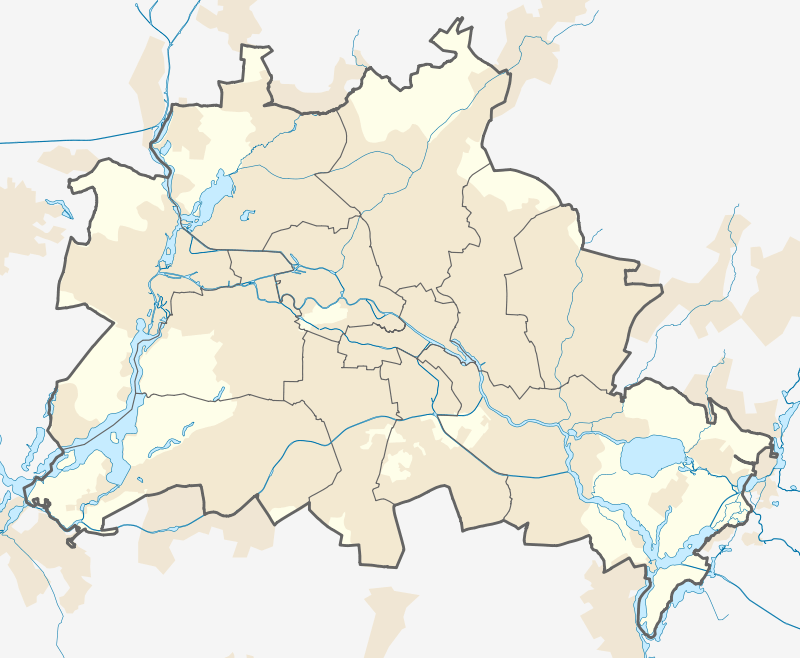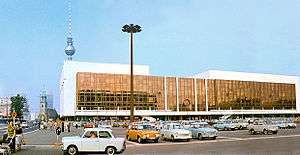Palace of the Republic, Berlin
| Palace of the Republic | |
|---|---|
| Palast der Republik | |
|
The Palace in the 1970s | |
 Location within Berlin | |
| General information | |
| Type | Cultural building, Parliamentary building |
| Location | Berlin, Germany |
| Coordinates | 52°31′03″N 13°24′10″E / 52.51750°N 13.40278°ECoordinates: 52°31′03″N 13°24′10″E / 52.51750°N 13.40278°E |
| Construction started | 1973 |
| Completed | 1976 |
| Inaugurated | 23 April 1976 |
| Demolished | 6 February 2006–2008 |
| Design and construction | |
| Architect | Heinz Graffunder and Karl-Ernst Swora |
The Palace of the Republic (German: Palast der Republik) in Berlin was the seat of the parliament of the German Democratic Republic (also known as East Germany), the Volkskammer (People's Chamber), and also served various cultural purposes. Located between Schlossplatz and the Lustgarten (referred to jointly as Marx-Engels-Platz from 1951 to 1994) on an island in the River Spree, it also housed two large auditoria, art galleries, a theatre, 13 restaurants, a bowling alley, a post office, and a discothèque. On 23 August 1990, the Volkskammer ratified the treaty on German reunification, which was later also confirmed by the Bundestag in Bonn. The building was constructed between 1973 and 1976 on the site of the former Berliner Stadtschloss (City Palace), and was completely demolished by 2008 to make room for a reconstruction of the Stadtschloss, which began in 2013.
History
Construction
The Palast was constructed from 1973 to 1976, having bronze-mirrored windows as a defining architectural feature. The grand opening ceremony was held on 23 April 1976, and the building was opened to the public two days afterwards on 25 April 1976. It was built on the site of the former Berliner Stadtschloss (Berlin City Palace), which was heavily damaged during World War II and eventually demolished by the government authorities in 1950, as they had no budget in the post-war years for the restoration of what they in any case regarded as a symbol of Prussian imperialism.
Asbestos contamination
Just prior to German reunification in October 1990, the structure was found to be contaminated with asbestos, and was closed to the public on 19 September 1990, by decree of the Volkskammer. By 2003, all the asbestos had been removed along with internal and external fittings allowing either safe reconstruction or safe deconstruction.
Demolition
Despite the fact that the majority of East Germans opposed the demolition[1] and various protests by people[2] who felt the building was an integral part of Berlin's culture and the historic process of the German reunification, in November 2003, the German parliament decided to demolish the building and leave the area as parkland until funding for the reconstruction of the Berlin City Palace could be found. Demolition started on 6 February 2006, and was scheduled to last about fifteen months at a cost of €12 million. The demolition lasted longer than scheduled because of hazards to neighbouring buildings. Dismantling of the structure was seriously delayed after more asbestos was discovered in various locations, and the estimated completion date was pushed back to the end of 2008.
About 35,000 tonnes of steel which once held this building together were shipped to the United Arab Emirates to be used for the construction of the Burj Khalifa.[3]
Future development
In January 2006 the Bundestag definitively voted for the rebuilding of the Prussian-era Stadtschloss. It was decided three of its sides would be exact replicas of the original, but the fourth side and interior would be modern. Called the Humboldtforum, the rebuilt palace will house the Humboldt collection and gallery of non-European art.[4]
In November 2008, the Italian architect Francesco Stella was chosen for the project.[5]
Noteworthy events held at the Palast

During the night of 22–23 August 1990, the Volkskammer decided in the Palace of the Republic the declaration on the accession of the German Democratic Republic (GDR) to the Federal Republic of Germany (FRG) with effect from 3 October 1990, when the five re-established states of the GDR joined the FRG.
Cultural, political, academic, and social events[6] at the Palast der Republik included concerts of famous orchestras such as the Gewandhausorchester Leipzig under Kurt Masur, modern interpretations of classical music such as the Messiah of George Frideric Handel, concerts of Bulat Okudzhava (29 November 1976), Harry Belafonte (25 October 1983), or of the rock-band Purple Schulz (21 January 1989).
German electronic music group Tangerine Dream performed a spectacular concert recorded live at the Palast der Republik on 31 January 1980 which also was Johannes Schmoelling's first live performance with the band. The concert was unique in that Tangerine Dream was the first Western group who was allowed by the Communist government to play in East Berlin at the time and was dubbed "the performance behind the Iron Curtain". An album of this recorded concert was released titled Quichotte on East German record label Amiga, and later released to the rest of the world on Virgin Records six years later and renamed Pergamon.
In October 1983, the West German rock star, Udo Lindenberg, was permitted to perform in concert at the Palast der Republik. At the concert, Lindenberg did not sing one of his best-known songs, "Sonderzug nach Pankow" ("Special Train to Pankow"), which satirized East German leader Erich Honecker, as he was asked not to play it.
Some of further noteworthy events hosted at the Palast der Republik included the party congresses of the Socialist Unity Party (SED) and the state gala on the eve of the 40th (and final) anniversary of the German Democratic Republic in October 1989, at which Soviet leader Mikhail Gorbachev was present.
The shell of the building was opened for visitors in mid-2003, and a pressure group campaigned for temporary use of the building for cultural events until its eventual demolition. Beginning in early 2004, the building was used for events such as housing an exhibition of the Terracotta Army and a special concert by the famous Berlin-based band Einstürzende Neubauten.
Other comments
The Palast had many nicknames in the Springer press in West Berlin and among East German citizens, such as "Palazzo Prozzo" (a wordplay, as 'protzen' means 'to show off') or "Erichs Lampenladen" (Erich's lamp shop). Although the original structure in Berlin has been demolished, its sister building the Kulturpalast in the city of Dresden is still intact and currently used as a symphony orchestra hall.
|
See also
External links
| Wikimedia Commons has media related to Palast der Republik. |
- Stop motion video of the demolition of the Palast der Republik.
- Opening of the Palace of the Republic in 1976. (English)
- Brokedown Palast – documentary film about the destruction of the Palast (English)
- Palast der Republik, at Schlossplatz, Historic Centre of Berlin (German) (with pictures)
- Zwischenpalastnutzung (Temporary Palace Use) (German)
- Documentary at Frontline/World (English)
- A site about the Palace (English)
- About the Palace in Berlin (German) (with a lot of pictures)
- Volkspalast, Special Prize of the Jury of the European Prize for Urban Public Space 2006
- fensterzumhof.eu: Deconstruction of the Volkspalast (photo series)
- "Dismantling, not Demolishing" (Short Ethnographic Film on the Deconstruction of PdR)
- Memories of East Germany's Showcase: New Book Reveals Last Photographs of Berlin's Palast der Republik(English)
References
- ↑ Berlin's Palace of the Republic Faces Wrecking Ball, retrieved 10 September 2011
- ↑ The Palace of the Republic in Berlin, retrieved 3 January 2011
- ↑ Berlin's Demolished Socialist Palace is Revived in Dubai, Deutsche Welle, 11 August 2008, retrieved 13 August 2008
- ↑ de:Humboldt-Forum
- ↑ Architect Chosen for Berlin Palace, The New York Times, 2008-10-28
- ↑ "Category:Events at the Palast der Republik - Wikimedia Commons". Commons.wikimedia.org. Retrieved 2012-11-07.






